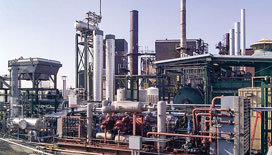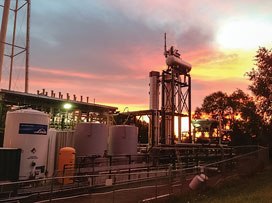Industry perspective
S. Kresnyak, Expander Energy, Calgary, Alberta, Canada;
and R. Schuetzle and D. Schuetzle, Greyrock Energy, Sacramento, California
NGL production is growing fast. According to RBN Energy, NGL production from natural gas processing increased in the US from 1.7 MMbpd in 2009 to almost 3 MMbpd in 2014, and is expected to continue growing to 4.5 MMbpd by 2019. NGL production far exceeds demand, and the gap is growing.
GTL refers to the conversion of gas-phase hydrocarbons into liquid hydrocarbons, primarily fuels. German scientists developed the technology in the 1920s to convert natural gas into liquid fuels, although it failed to gain widespread popularity due to high capital costs and long development cycles to commercialize the technology.
To date, only a few large-scale plants operate commercially around the world, mainly by Shell and Sasol in locations such as Qatar, South Africa and Malaysia. Combined, these facilities produce several hundred thousand barrels of fuels and chemicals per day—a relatively small amount compared to worldwide demand.
Several other large-scale plants have been announced worldwide, but all are multibillion-dollar projects with long construction cycles. Such large projects can only be sited in a few locations due to the required massive natural gas reserves to support such projects on a 20-year basis or longer.
Small-scale GTL trend. In the last few years, the small-scale GTL industry has evolved, with several technology vendors working aggressively to deploy the first small-scale GTL plant and become a platform standard within this market.
Most GTL projects focus on the use of natural gas (either pipeline gas or field gas) for conversion into fuels. However, as NGL production grows, the opportunity to use ethane or propane as a feedstock is growing.
If the GTL plant uses a system design that is feedstock-flexible, then that optionality provides downside risk and operational versatility to the plant operator. Feedstock flexibility means that the GTL plant enables the use of a variety of hydrocarbon feedstocks. Plants will need to be sized appropriately to take advantage of the opportunity, most likely requiring a modular construction approach.
Some of the emerging, small-scale, distributed GTL platforms provide a way to convert a variety of feedstocks into easily transported premium diesel fuel and other hydrocarbon products. Feedstocks can be varied and include natural gas, ethane, propane, butane, C5+/condensate and a mixed Y-grade.
Plants that incorporate a feedstock-flexible design can switch between feedstocks within short periods of time, therefore providing the widest flexibility for capturing the spread between these inputs and liquid fuels in a local market area.
Ethane feed opportunities. Today, natural gas, ethane and—in some locations—propane are the lowest-cost feedstocks, and would be the most likely candidates to be used in a distributed GTL plant.
In some geographies, ethane accounts for close to half of the NGL stream, making it a major challenge for producers and midstream operators in liquids-rich basins. Ethane can be rejected into the natural gas steam, thereby increasing the energy content of the natural gas (Btu/ft3). However, limits on rejections are close to being reached on pipelines, especially in the Northeast.
Ethane that is recovered and kept in the NGL stream cannot easily be consumed locally and, therefore, needs to be sent to a major processing hub for fractionation. This is done by sending a mixed NGL stream (which includes ethane and other NGL) to one of two major processing hubs: Mt. Belvieu, Texas or Conway, Kansas in the US. As of July, ethane is priced at approximately $0.18/gal at both of these locations.
However, to deliver the ethane to these hubs, transportation and fractionation (T&F) costs must be incurred. In some locations, T&F costs are higher than the ethane price at Mt. Belvieu or Conway.
One solution to the ethane problem is to use “distributed GTL” systems to produce premium diesel fuel and other liquid hydrocarbon products that can be easily used in local markets, thereby solving major logistical challenges. The built-in feedstock flexibility of such plants provides a hedge on ethane prices, enabling the use of other local feedstocks in the event that ethane prices rise (Fig. 1).
 |
|
Fig. 1. A distributed GTL facility is designed to be |
Growing propane oversupply. While propane is a higher-value product in many market areas, oversupply of propane is beginning to occur in specific markets. According to RBN Energy, spot propane prices in Edmonton, Alberta were assessed in June by Oil Price Information Service (OPIS) at a negative value (–0.625 cents/gal), meaning that producers had to pay to get rid of propane. Oversupply worries are also surfacing in the Bakken and Marcellus/Utica shale plays, as well as in other liquids-rich regions.
While negative feedstock prices will not persist, this pricing event points to challenging propane markets this summer. Without additional demand sources, the problem will grow, creating another opportunity for feedstock-flexible GTL plants.
If feedstock is contracted responsibly and the plants are sited correctly, then distributed GTL plants may also be able to take advantage of spot feedstock opportunities, such as the propane pricing highlighted earlier. This flexibility would allow an operator to fall back on natural gas as the cheapest source of feedstock.
Distributed GTL projects. A number of GTL companies have announced first commercial projects. Beyond first-wave GTL plants, siting in locations that take advantage of a variety of NGL and natural gas feedstocks could be attractive (Fig. 2).
 |
|
Fig. 2. Distributed GTL facility siting can take |
Proposed GTL plants include traditional Fischer-Tropsh (F-T), methanol-to-gasoline and newer approaches that enable the direct production of liquid fuels from syngas, eliminating the upgrading/refining step that is required with traditional F-T.
Most in the industry believe that, for GTL to be economical at distributed plant scales, alternative approaches that are different from the ones used at multibillion-dollar plant scales will be required to succeed economically. These alternative approaches enable use of flexible feedstocks, reduce capital and operating expenses and also improve yields.
Expander Energy and Greyrock Energy have partnered to develop GTL facilities in Canada and the US. The companies have combined technologies to offer a distributed GTL solution, in addition to holding the patent rights related to NGL feedstocks for GTL plants. GP
 |
Steve Kresnyak is CTO of Expander Energy, a technology company providing innovative solutions for the environmental and economic production of synthetic fuels. He has over 35 years of EPC and EPCM experience and supports WorleyParsons as a technical specialist for front-end development of gas, heavy oil and bitumen projects and technology development. Mr. Kresnyak has authored and presented several patents and technical papers. He holds a BEng degree in mechanical engineering from the University of Alberta in Alberta, Canada.
 |
Robert Schuetzle is the co-founder and CEO of Greyrock Energy Inc., which was established in 2009. He specializes in energy innovation and in assembling teams to solve complex challenges and grow new businesses. Mr. Schuetzle holds an engineering degree from the University of Michigan in Detroit.
 |
Dennis Schuetzle is CTO at Greyrock Energy Inc. He has 41 years of experience in managing scientific and engineering research, product development and manufacturing, renewable energy and fuel production processes, and environmental science and technology programs in collaboration with organizations in North America, Asia, Europe, South America, Russia and South Africa. He is also President of Renewable Energy Institute International.




Comments